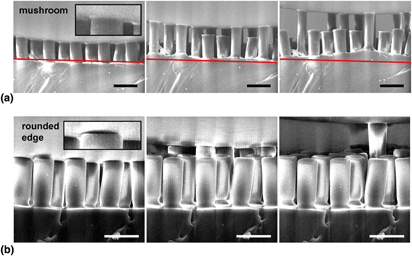Crossref Citations
This article has been cited by the following publications. This list is generated based on data provided by
Crossref.
Paretkar, Dadhichi R.
Bartlett, Michael D.
McMeeking, Robert
Crosby, Alfred J.
and
Arzt, Eduard
2013.
Buckling of an Adhesive Polymeric Micropillar.
The Journal of Adhesion,
Vol. 89,
Issue. 2,
p.
140.
Bauer, Christina T
Kroner, Elmar
Fleck, Norman A
and
Arzt, Eduard
2015.
Hierarchical macroscopic fibrillar adhesives:
in situ
study of buckling and adhesion mechanisms on wavy substrates
.
Bioinspiration & Biomimetics,
Vol. 10,
Issue. 6,
p.
066002.
Purtov, Julia
Frensemeier, Mareike
and
Kroner, Elmar
2015.
Switchable Adhesion in Vacuum Using Bio-Inspired Dry Adhesives.
ACS Applied Materials & Interfaces,
Vol. 7,
Issue. 43,
p.
24127.
Isla, Paula Yagüe
and
Kroner, Elmar
2015.
A Novel Bioinspired Switchable Adhesive with Three Distinct Adhesive States.
Advanced Functional Materials,
Vol. 25,
Issue. 16,
p.
2444.
Neubauer, Jens W.
Xue, Longjian
Erath, Johann
Drotlef, Dirk-M.
Campo, Aránzazu del
and
Fery, Andreas
2016.
Monitoring the Contact Stress Distribution of Gecko-Inspired Adhesives Using Mechano-Sensitive Surface Coatings.
ACS Applied Materials & Interfaces,
Vol. 8,
Issue. 28,
p.
17870.
Hensel, René
Moh, Karsten
and
Arzt, Eduard
2018.
Engineering Micropatterned Dry Adhesives: From Contact Theory to Handling Applications.
Advanced Functional Materials,
Vol. 28,
Issue. 28,
Tinnemann, Verena
Arzt, Eduard
and
Hensel, René
2019.
Switchable double-sided micropatterned adhesives for selective fixation and detachment.
Journal of the Mechanics and Physics of Solids,
Vol. 123,
Issue. ,
p.
20.
Croll, Andrew B.
Hosseini, Nasibeh
and
Bartlett, Michael D.
2019.
Switchable Adhesives for Multifunctional Interfaces.
Advanced Materials Technologies,
Vol. 4,
Issue. 8,
Arzt, Eduard
Quan, Haocheng
McMeeking, Robert M.
and
Hensel, René
2021.
Functional surface microstructures inspired by nature – From adhesion and wetting principles to sustainable new devices.
Progress in Materials Science,
Vol. 120,
Issue. ,
p.
100823.
Arzt, Eduard
Quan, Haocheng
McMeeking, Robert M.
and
Hensel, René
2021.
WITHDRAWN: Functional surface microstructures inspired by nature – From adhesion and wetting principles to sustainable new devices.
Progress in Materials Science,
Vol. 119,
Issue. ,
p.
100778.
Baban, Navajit S
Orozaliev, Ajymurat
Kirchhof, Sebastian
Stubbs, Christopher J
and
Song, Yong-Ak
2022.
Biomimetic fracture model of lizard tail autotomy.
Science,
Vol. 375,
Issue. 6582,
p.
770.
Luo, Chao
Ma, Xinguo
Zhang, Yaling
Peng, Yan
Zhou, Yi
Zhao, Xiuli
and
Zhang, Fengshun
2024.
Multiscale Synergistic Gecko-Inspired Adhesive for Stable Adhesion under Varying Preload and Surface Roughness.
Langmuir,
Vol. 40,
Issue. 19,
p.
9957.
